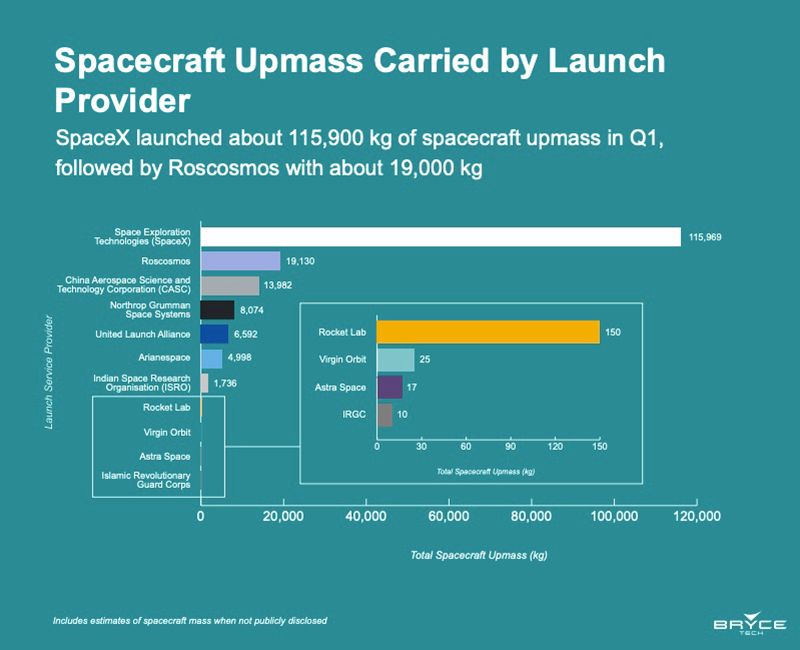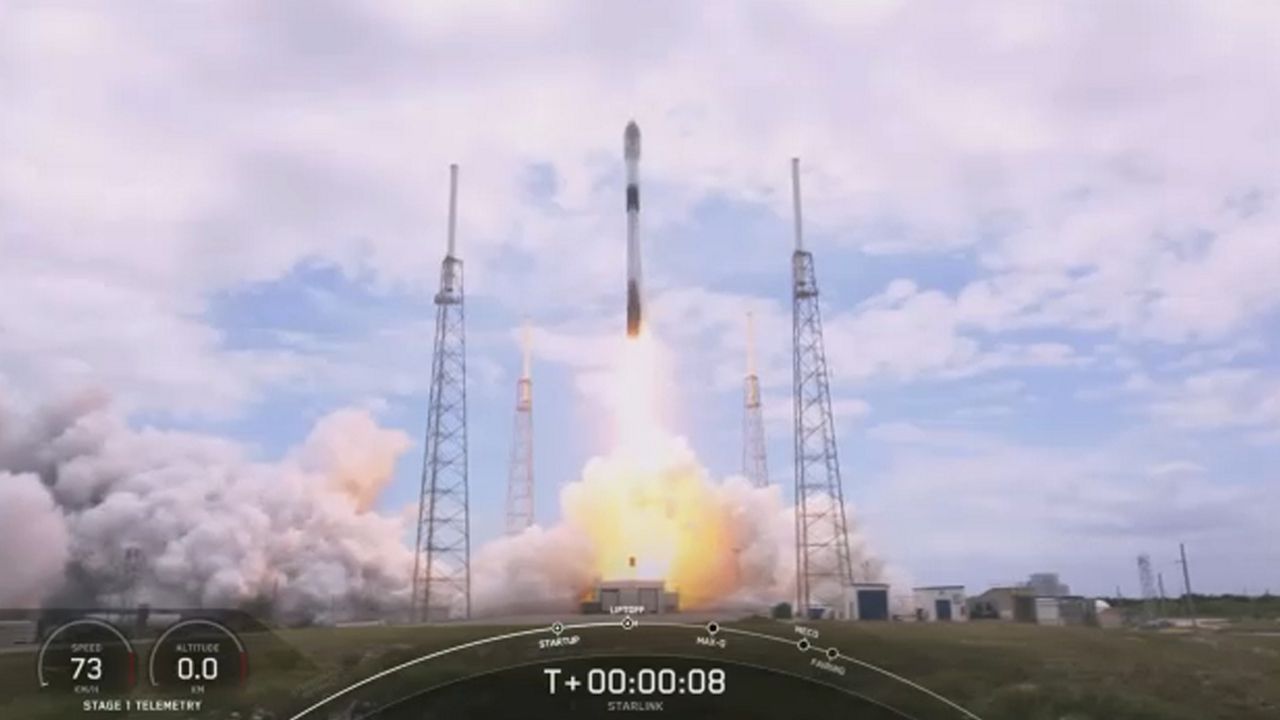CAPE CANAVERAL, Fla. — To say that SpaceX is having a busy month would be an understatement at this point. The California-based company is helping to coordinate two crewed missions heading from and to the International Space Station.
Adding to the mix, the company on Thursday sent another batch of its Starlink internet satellites into low-Earth orbit with a successful liftoff at 1:51 p.m. EDT from Space Launch Complex 40 (SLC-40) at Cape Canaveral Space Force Station.
The launch came after the time was pushed later due to weather earlier in the day.
What You Need To Know
- Thursday’s Starlink launch was the 15th for the company in 2022
- All but one of SpaceX’s launches this year have been from the Space Coast
- A market analysis shows that SpaceX continues to dominate the launch market with 502 spacecraft launched in the first quarter
- Scroll down to watch the launch
Minutes later, the Falcon 9's first stage landed successfully on the "Just Read the Instructions" droneship in the Atlantic Ocean. That completed the booster rocket's 12th launch and landing.
Starlink Group 4-14
The mission is “Starlink Group 4-14” is the 12th cluster of satellites to be added to the fourth shell of the internet constellation.
This marked the fourth launch for SpaceX in April, with the potential for another two missions in the final week of the month.
In a recent tweet, founder Elon Musk noted that the team behind the Falcon 9 rocket has been hard at work and is aiming for a five-day launch cadence. Late last month, Musk said in another tweet that SpaceX was aiming for 60 launches this year.
If achieved, that would be nearly double the record 31 launches the company completed in 2021.
SpaceX Falcon team making great progress! Aiming for 5 day launch cadence with many performance & refurb improvements.
— Elon Musk (@elonmusk) April 18, 2022
Return and Off Again
SpaceX's Crew-4 mission will be delayed again. It was set to go off on Saturday morning at 5:26 a.m. EDT, but now the earliest the launch could happen now is Tuesday at 4:15 a.m. EDT.
Part of the reason for the delay is because the Axiom Mission 1 Crew's return to Earth has been delayed.
Bad weather has prevented the first all-private crew from undocking from the International Space Station. Currently, they are scheduled to leave Saturday night, with a splashdown happening on Sunday.
NASA, Axiom, and SpaceX are still working on a plan to get them back home.
When it comes to Crew-4, their launch needs to happen after the Ax-1 crew leaves, so the new crew has enough room to dock on the ISS.
Launch, rinse, repeat
The model of reusability has proven a successful venture for SpaceX over the past several years. The first stage boosters of its Falcon 9 rockets are designed to land on droneships out in the ocean and return them safely to port for refurbishment.
The booster, B1060-12, used Thursday is one of the flight leaders in the Falcon 9 fleet, used for its 12th launch and landing. It was previously used for the GPS III-3, Turksat 5A and Transporter-2 missions, along with eight Starlink launches.
Thursday’s launch was the 15th launch for SpaceX in 2022, with all but one mission, NROL-85 for the National Reconnaissance Office, having launched from Florida’s Space Coast.
This launch cadence continues to demonstrate the dominance that SpaceX currently holds in the launch market. A Q1 analysis by analytics and engineering firm BryceTech noted that SpaceX led in all of the metrics presented.
SpaceX launched 11 times in the first quarter, edging out the eight launches from the China Aerospace Science and Technology Corporation (CASC) and the four from Roscosmos, Russia’s space agency.
Comparing both the number of spacecraft and upmass carried by launch providers in that same timeframe, SpaceX was drastically ahead of other launch providers.
The company launched 502 spacecraft in Q1. CASC came in the number two spot with 38 spacecraft, followed by Arianespace with 34. Notably, market newcomer Astra Space launched 21 spacecraft in Q1 with its successful launch from Alaska and its failed deployment following its Cape Canaveral debut.
SpaceX also sent 115,969 kg of payloads into orbit. Roscosmos and CASC came in second and third in this category respectively with 33,112 kg combined.
The launch of Starlink and OneWeb satellites dominated the launches so far this year, with communications satellites dominating the type of spacecraft launched in Q1 at 75%.

Musk said in late March that he expected to have more than 4,200 Starlink satellites in operation “within 18 months,” which he said would account for about two-thirds of all active satellites around Earth.
Starlink impact
As SpaceX continues to expand the scope and scale of its Starlink constellation, it continues to expand real-world impacts.
In a statement on April 5, the U.S. Agency for International Development (USAID) said it had “delivered 5,000 Starlink terminals to the Government of Ukraine through a public-private partnership with the American aerospace manufacturer, SpaceX.”
An earlier draft of the release stated that SpaceX donated 3,667 terminals “valued at roughly $10 million.”
On Tuesday, April 19, Mykhalio Fedorov, the Vice Prime Minister of Ukraine and Minister of Digital Transformation of Ukraine, took to Twitter again to note the impact that the terminals are having amid the Russian invasion of the Ukraine.
Is Starlink that important? It wouldn't be possible to restore 10 km of cable connection between villages in Chernigiv region after serious battles so quick. Normally it takes few months. Another case: provider Baryshivka-Net resumed the network for 5 villages by using only 1 📡. pic.twitter.com/VPY7nMAlz4
— Mykhailo Fedorov (@FedorovMykhailo) April 19, 2022
During the C4ISRNET Conference on Wednesday, April 20, Dave Tremper, the director of electronic warfare for the Office of the Secretary of Defense, noted the ability of SpaceX to change some lines of code to thwart Russian attempts to jam its Starlink satellites.
“We need to be able to have that agility,” Tremper said, according to C4ISRNET. “We need to be able to change our electromagnetic posture to be able to change, very dynamically, what we’re trying to do without losing capability along the way.”
Also on Wednesday, NASA announced that SpaceX was among the six American satellite communications (SATCOM) providers chosen to help bolster near-Earth space communication services for future missions.
The Communications Services Project (CSP) agreement is worth about $278.5 million, of which SpaceX will receive $69.95 million. Amazon’s Project Kuiper system received the next biggest award amount with $67 million.
NASA stated that each of the six companies need to ”complete technology development and in-space demonstrations by 2025.” The agency would then procure multiple, long-term contracts for near-Earth services by 2030 in order to phase out its own NASA-operated systems and become a customer.



